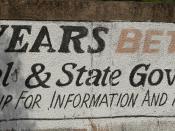Union Carbide & Carbon Corporation were incorporated on November 1, 1917, and acquired the stock of Linde Air Products Co., National Carbon Co. Inc., Prest-O-Lite Co. Inc., and Union Carbide Company. Then two years later, George Curme files the first patent for commercial preparation of ethylene. The expansion of the company started the following year with new plants at Clendenin, W. Va. - which was the start of the petrochemical industry.
Union Carbide also established Carbide and Carbon Chemicals Corporation on that same year.
A few years later, eleven acres of land in South Charleston, W. Va. were leased to set up a commercial scale plant, which will begin production of several ethylene-based chemicals in just a few years. Another expansion of the company took place when Bakelite Corporation merged into Union Carbide and Carbon Corporation. Bakelite, founded by Dr. Leo Baekeland, was a pioneer in plastics. In the following decade, more expansions took place, Union Carbide purchased a plant in Institute, W.
Va., which it had previously built and operated for the government for the production of butadiene and styrene at the start of World War II.
Then in 1957, the Union Carbide & Carbon Corporation decided to change its name to Union Carbide Corporation.
On 1959, the company started to divide the company into several different divisions. The first division of the company was the Union Carbide Consumer Products Co. In the following decade, four more divisions were added, The Mining and Metals Division which was formed by combining the Metals and Ore Divisions and part of the Nuclear Division. Electronics Division was also established. Hydrocarbons Division was formed as well. The last division was the Ferroalloys Division which took over productions and marketing of chromium, manganese and silicon alloys. Division was not the only things that...


